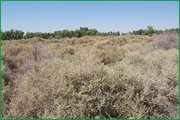Antelope Plain (Bailey)
Contents
Lithology and Stratigraphy
This subsection contains late Quaternary alluvium. The alluvium is predominantly from sedimentary rocks sources in the Temblor Range of the Coast Ranges.
Geomorphology
This subsection is on nearly level to gently sloping alluvial fans. The subsection elevation range is from 250 to about 1200 feet. Fluvial erosion and deposition are the main geomorphic processes.
Soils
The soils are mostly Typic Torriorthents, and lesser amounts of Typic Natrargids. The soils are well drained. Leaching and accumulation of clay and calcium carbonates in subsoils are the main pedogenic processes, but most of the soils are too young to have argillic and calcic horizons. The soil temperature regimes are thermic. Soil moisture regimes are aridic.
Vegetation
The predominant natural plant communities are Allscale series, and, on floodplains and toe slopes, Greasewood series.
Characteristic series by lifeform include:
Climate
The mean annual precipitation is about 5 to 6 inches. It is practically all rain. Mean annual temperature is about 59° to 62° F. The mean freeze-free period is about 250 to 275 days.
Surface Water
The streams drain from the Coast Ranges toward the basin at the toes of the fans. All streams are small and dry during the summer. There are no lakes.
